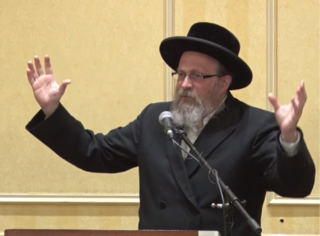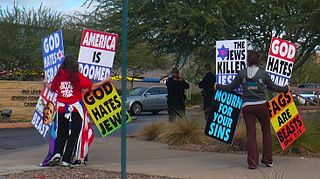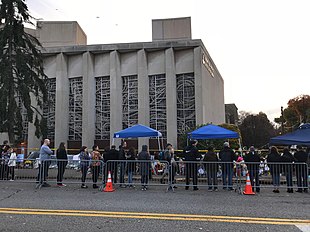
Messianic Judaism is a modernist and syncretic movement of Protestant Christianity that incorporates some elements of Judaism and other Jewish traditions into evangelicalism.

Squirrel Hill is a residential neighborhood in the East End of Pittsburgh, Pennsylvania, United States. The city officially divides it into two neighborhoods, Squirrel Hill North and Squirrel Hill South, but it is almost universally treated as a single neighborhood.
Jews in Philadelphia can trace their history back to Colonial America. Jews have lived in Philadelphia since the arrival of William Penn in 1682.
The history of the Jews in Pennsylvania dates back to Colonial America.

Rodef Shalom Congregation is a National Register of Historic Places landmark in Pittsburgh, Pennsylvania, designed by architect Henry Hornbostel.

HIAS is a Jewish American nonprofit organization that provides humanitarian aid and assistance to refugees. It was originally established in 1881 to aid Jewish refugees. In 1975, the State Department asked HIAS to aid in resettling 3,600 Vietnam refugees. Since that time, the organization continues to provide support for refugees of all nationalities, religions, and ethnic origins. The organization works with people whose lives and freedom are believed to be at risk due to war, persecution, or violence. HIAS has offices in the United States and across Latin America, Europe, Africa, and the Middle East. Since its inception, HIAS has helped resettle more than 4.5 million people.

Rabbi Moshe Weinberger is an American Chasidic rabbi, outreach educator, author, translator, and speaker. He is the founding rav of Congregation Aish Kodesh in Woodmere, New York, and former Mashpia/mashgiach ruchani at the Rabbi Isaac Elchanan Theological Seminary (RIETS). To date, he has recorded more than 5000 lectures on chasidic thought and philosophy as well as halacha and a variety of other topics in Judaism.

Antisemitism has existed for centuries in the United States. Most Jewish community relations agencies in the United States draw distinctions between antisemitism, which is measured in terms of attitudes and behaviors, and the security and status of American Jews, which are both measured by the occurrence of specific incidents. FBI data shows that in every year since 1991, Jews were the most frequent victims of religiously motivated hate crimes, according to a report which was published by the Anti-Defamation League in 2019. Evidence suggests that the true number of hate crimes against Jews is underreported, as is the case for many other targeted groups.

Temple Emanuel is a Reform synagogue located on the east side of Davenport, Iowa, United States. Organized in 1861, it is the oldest Jewish congregation in Iowa. It is affiliated with the Union for Reform Judaism (UAHC).

The Jewish community of Houston, Texas has grown and thrived since the 1800s. As of 2008 Jews lived in many Houston neighborhoods and Meyerland is the center of the Jewish community in the area.

Rabbi Zalman I. Posner was an American rabbi and writer associated with the Chabad-Lubavitch Hasidic movement. Posner served as a congregational rabbi and community leader in the American Southeast for five decades, serving the Orthodox congregation Sherith Israel and founding an Orthodox Day School both in Nashville, Tennessee.
Congregation Kol Ami is a synagogue located in Salt Lake City, Utah. It is affiliated with both the Union for Reform Judaism and the United Synagogue of Conservative Judaism, and, according to the synagogue, it serves 25% of the Jewish families in Utah.

Society Hill Synagogue is a synagogue located in the Society Hill section of Center City, Philadelphia. The synagogue is home to a 300-household congregation with Shabbat and holiday services, a Playschool for children 18 months to 5 years old, a Hebrew School for pre-kindergartners through high school students, adult education, social and communal activities, impactful social action, and engaging intergenerational programs.

The Broken Hill Synagogue is a heritage-listed former synagogue and now museum at 165 Wolfram Street, Broken Hill, City of Broken Hill, New South Wales, Australia. The property is owned by the Broken Hill Historical Society. It now houses the Synagogue of the Outback Museum. It was added to the New South Wales State Heritage Register on 2 April 1999.

The Pittsburgh synagogue shooting was an antisemitic terrorist attack that took place at the Tree of Life – Or L'Simcha Congregation synagogue in the Squirrel Hill neighborhood of Pittsburgh, Pennsylvania. The congregation, along with New Light Congregation and Congregation Dor Hadash, which also worshipped in the building, was attacked during Shabbat morning services on October 27, 2018. The perpetrator killed eleven people and wounded six, including several Holocaust survivors. It was the deadliest attack on the Jewish community in the United States.

Tree of Life – Or L'Simcha Congregation is a Conservative Jewish synagogue in the Squirrel Hill neighborhood of Pittsburgh, Pennsylvania. The congregation moved into its present synagogue building in 1953. It merged with Congregation Or L'Simcha in 2010, bringing its membership to 530 families.
Neal Rosenblum was shot and killed on Thursday, April 17, 1986 by Steven M. Tielsch in Pittsburgh. The attack was motivated by antisemitic hate.
The Poway synagogue shooting occurred on April 27, 2019, at Chabad of Poway synagogue in Poway, California, United States, a city approximately 20 miles (32 km) north of San Diego, on the last day of the Jewish Passover holiday, which fell on a Shabbat. Armed with an AR-15 style rifle, John Timothy Earnest fatally shot one woman and injured three other persons, including the synagogue's rabbi. After fleeing the scene, Earnest phoned 9-1-1 and reported the shooting. He was apprehended in his car approximately two miles (3.2 km) from the synagogue by a San Diego police officer.

















